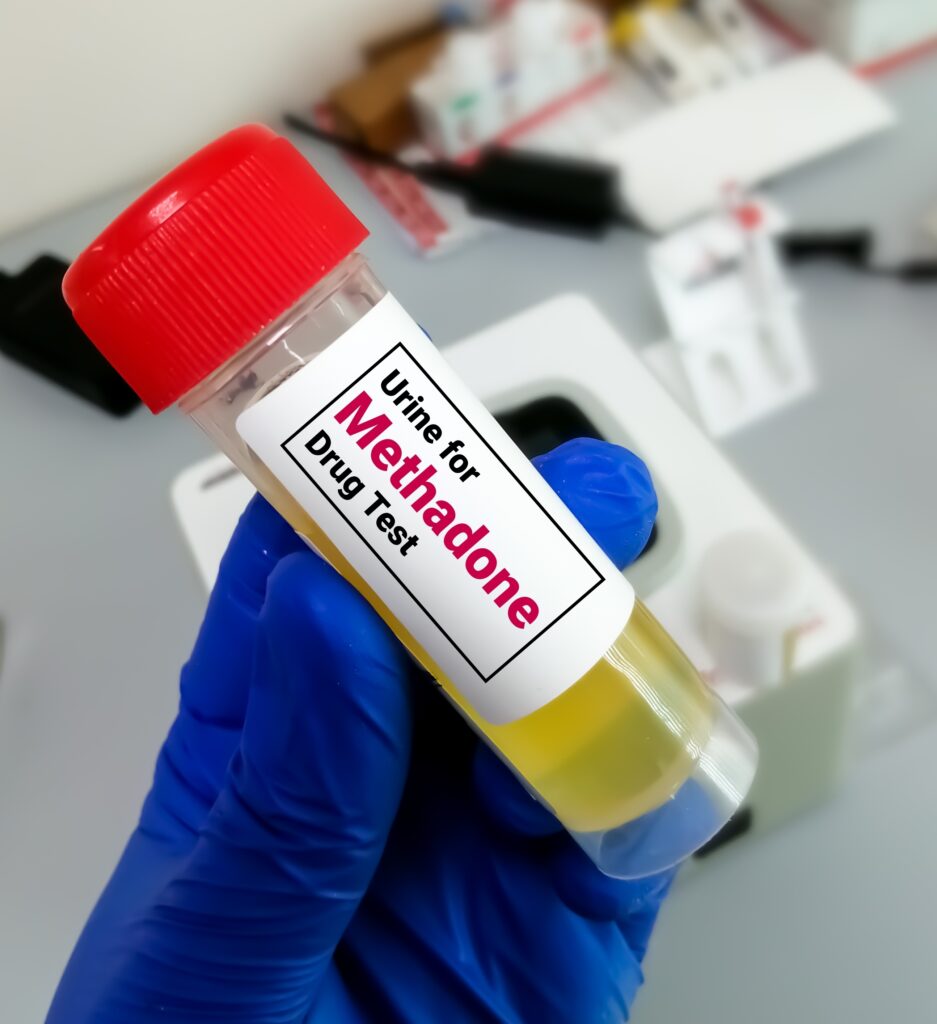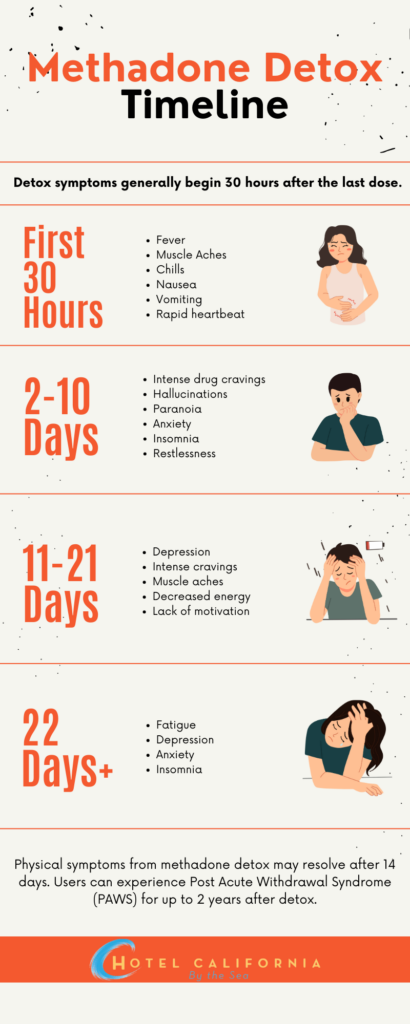How long does it take Methadone to leave the system?
Methadone is a prescription medication commonly used to treat symptoms of opioid use disorder. It is most often used for medication-assisted treatments during detox and even throughout the remainder of opioid addiction treatment. This synthetic opioid is a narcotic medication and is considered a Schedule II Controlled Substance. Despite being a popular and effective medication treatment for opioid addiction, methadone itself can become habit-forming if not administered under the care of a healthcare provider and medical treatment program.

Methadone works by affecting the central nervous system’s response to pain. It blocks painful opioid withdrawal symptoms, as well as the euphoric effects normally associated with feeling high. For this reason, it is one of the popular treatment methods in helping those with opioid use disorder.
When the medication is used in methadone maintenance treatment, the opioid can remain active in the system anywhere between 8-36 hours. Because the opioid is long-lasting, it can stay in the body for significantly longer than other medications. In the case of drug dependence, withdrawal might not even begin until a week after the initial dose because the drug is still circulating within the body long after use has stopped.
How long does Methadone take to leave the system?
So how long does it take for Methadone to completely be eliminated from the body? There are many different factors that influence how long it takes for a drug to be metabolized. These factors include:
- Age – The older you are, the longer it will take to process the drug and be eliminated from your system.
- Height and weight – Your overall body measurements can impact how slow or fast you process the drug.
- Individual metabolism – Your individual metabolic rate impacts how long methadone stays in your system.
- History of other medical health conditions – A history of liver and kidney conditions can impede the processing of the drug in the body.
- Frequency of methadone use – How often you use the drug impacts how quickly your body can metabolize.
- Quantity of methadone used – If you’re ingesting high amounts of the drug, it could take longer for the body to process.
- The use of other substances – Polydrug use can make it more difficult for the body to process and eliminate the drug from your system.
In a user who is opioid dependent, the half-life of methadone is an average of 30 hours. In a user who is non-opioid dependent, the half-life of methadone is an average of 55 hours. In a user with a physiological tolerance to opioids, the half-life of methadone could extend beyond 50 hours. It takes about five half-lives for the body to fully eliminate methadone. On average, methadone can stay active in the body between 2-13 days and is generally eliminated within two weeks. However, in cases of long-term methadone users, it can take even longer for the body to process the drug.
What is the window of detection for methadone? In a blood test, methadone can remain detectable for up to several hours after the initial dose. In a urine test, methadone can remain detectable for up to 12 days after the initial dose. In a saliva test, methadone can remain detectable for up to 10 days after the initial dose.

How long do the effects of Methadone last?
When methadone is used for pain management treatment, the effects of the synthetic opioid can last for as long as eight hours. The effects of the medication generally last between 8-12 hours. The onset of the impact can begin within 30 minutes after ingestion. During methadone maintenance treatment, the effects of the medication can last as long as 36 hours. The duration of the effects of methadone is also dependent on the individual patient, the quantity of dosage and the duration of drug treatment.
Methadone Withdrawal
Methadone withdrawal occurs when drug use has stopped and the body tries to rebalance itself and learn how to perform normal functions without the presence of methadone in the system. During this period, the body can produce uncomfortable symptoms as it scrambles to relearn how to establish oneself without drugs.
Opioids impact the way your brain works by flooding it with neurotransmitters. During the detox phase when you remove opioids from your body, the brain then has to operate on decreased amounts of neurotransmitters. It can take up to six months for the brain to rebalance itself and return to a normal state. Before this happens, the body experiences symptoms of withdrawal.
Withdrawal symptoms can present within 24 hours of the last dose and can last anywhere between 3-6 weeks. Because methadone is a long-acting opioid, withdrawal onset is slower and can last longer compared to other drugs.
Check Your Insurance Coverage for FREE
Find out if your insurance covers addiction treatment in minutes. We accept most insurance!
Common Methadone withdrawal symptoms:
- Chills
- Fever and excessive sweating
- Anxiety
- Muscle ache
- Nausea and vomiting
- Rapid heartbeat
- Stomach cramps
- Irritability and paranoia
- Drug cravings
- Low energy
- Difficulty with memory and concentration
- Low tolerance for stress
- Insomnia and difficulty sleeping
- Hallucinations
- Depression
- Flu-like symptoms
- Gastrointestinal issues
- High blood pressure
Withdrawal Timeline
- Day 1-2 – Withdrawal can begin about 30 hours after the last dose. Physical symptoms can include fever, chills and muscle aches.
- Day 3-8 – More intense symptoms include urges and cravings to use methadone, development or worsening of anxiety, body aches, nausea, irritability and difficulty sleeping. During this phase, symptoms can peak over the week and users may develop flu-like symptoms as well as worsening depression.
- Day 9-15 – During this period, symptoms may begin to subside. However, cravings may increase and strong feelings of depression can set in. The combination of both can make it more difficult for the user to stay motivated to maintain sobriety.
- Over 15 days – During this time, users can experience low energy, anxiety and persistent cravings. In some severe cases, some users can experience post-acute withdrawal syndrome (PAWS) that can continue for months. In extreme cases, PAWS can last for years. Symptoms of PAWS include worsening anxiety and depression, inability to feel pleasure and difficulty concentrating.
Like other opioids, methadone dependence can be difficult to overcome. The best way to treat a methadone addiction is to gradually taper off the medication. The World Health Organization (WHO) recommends gradually reducing methadone doses by 5-10mg per week until the dose of 40mg has been reached. Once the patient has reached 40mg, the dosage should be decreased by 5mg per week until the medication is no longer needed. However, this is just a general recommendation for tapering. Patients should discuss with their healthcare provider for the best course of action unique to their condition.
Reach out to Hotel California by the Sea
We specialize in treating addiction and other co-occurring disorders, such as PTSD. Our Admissions specialists are available to walk you through the best options for treating your addiction.
Are you looking for Opioid Addiction Treatment?
Methadone is a prescription medication used in the treatment of opioid use disorder. Because methadone is an opioid, when used in circumstances outside of the recommendation of a health care provider, it can become habit-forming and cause addiction. Because methadone is a long-acting opioid, it can remain in the body for long periods of time, making the onset of withdrawal and duration of withdrawal much longer and more uncomfortable to endure. The most effective treatment for an addiction to opioids is through a behavioral health treatment program such as Hotel California by the Sea.
Our program provides treatment through every step of the rehab process including detox, residential, and outpatient programs. We utilize evidence-based treatment methods that include CBT, DBT and EMDR therapy. Hotel California by the Sea is dedicated to providing the tools and resources for patients to successfully overcome their addiction.
References:
https://www.addictioncenter.com/opiates/methadone/withdrawal-detox
https://www.verywellmind.com/methadone-withdrawal-4178352
https://www.methadonecenters.com/how-long-does-methadone-last
https://www.eleanorhealth.com/blog/how-long-is-methadone-withdrawal
https://anrclinic.com/blog/how-long-does-methadone-stay-in-your-system
https://www.methadone.org/how-long-does-methadone-stay-in-your-urine
